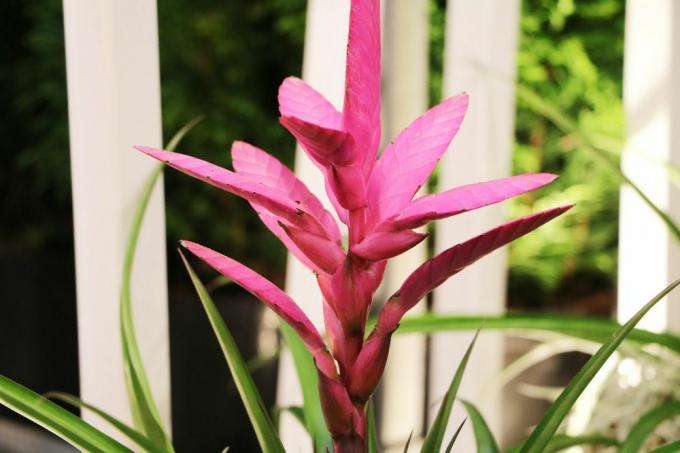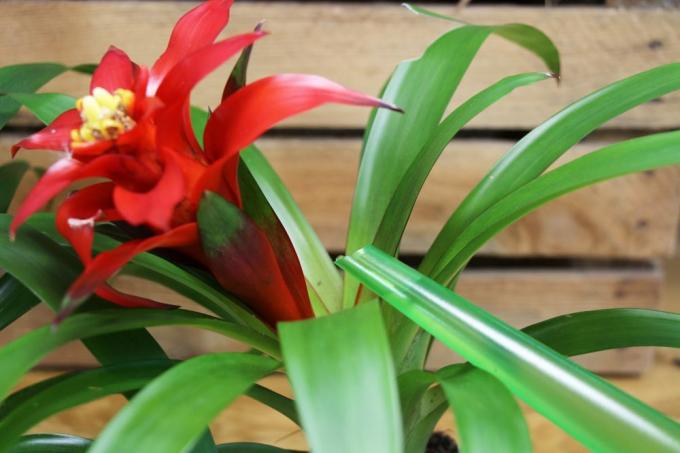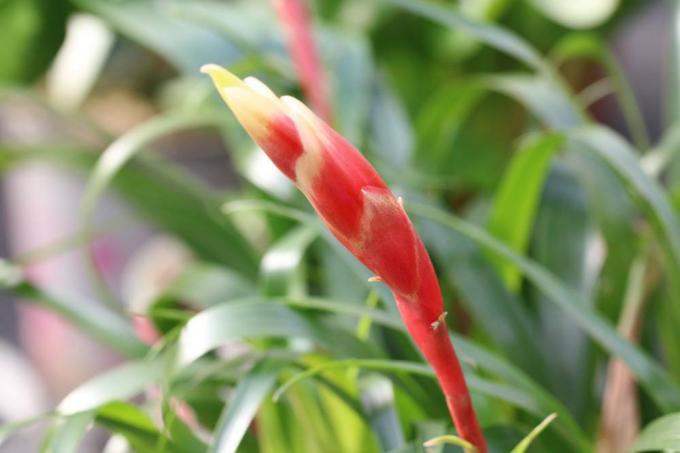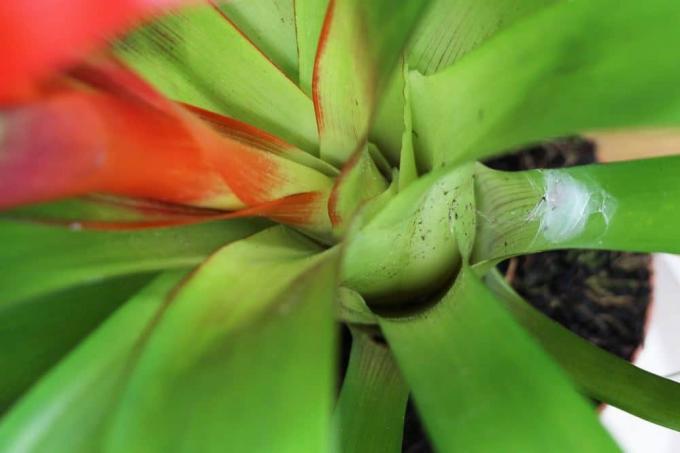
table of contents
- Characteristics
- Likelihood of confusion
- Location
- Buy preferred potted plants
- Substrate
- Repot
- care
- to water
- Fertilize
- Cut
- Overwinter
- Multiply
- Pests and diseases
- Toxicity
Profile and care information open +conclude -
- Flower color
- yellow white
- Location
- Partial shade, sunny
- Growth habit
- upright, expansive
- height
- up to 10 meters high
- Soil moisture
- moderately moist, fresh
- PH value
- weakly acidic
- Limescale tolerance
- Calcium intolerant
- humus
- rich in humus
- Poisonous
- Yes
- Plant families
- Bromeliads, Bromeliaceae
- Plant species
- Ornamental plants, house plants
- Garden style
- Pot garden, winter garden
The bromeliad is a unique sight in your own four walls. The tropical plants immediately catch the eye with their green foliage and inflorescences, which inspire in different colors. The Bromelia are one of the genera with smaller species within the plant family and for this reason they are well suited for keeping in pots. As long as wintering is not missed, the plants are undemanding.
Characteristics
- Genus: Bromeliad (Bromelia)
- Family: Bromeliad (Bromeliaceae)
- Growth height: up to 10 meters high
- Leaves: slender, lanceolate leaves of different lengths, green, equipped with scaly hairs
- Blossom: differently colored, threefold flowers in racemes or panicles, have bracts with spines
- Flowering time: strongly dependent on species
- Origin: southern United States to southern Chile, the Caribbean, western Guinea
- not hardy
- not lime tolerant
- evergreen
Likelihood of confusion
The term bromeliad is extremely extensive and can be either within the genus Bromelia Subfamily Bromelioideae or the plant family Bromeliaceae mean to which this subfamily is incorporated. This makes the assignment of the individual species very confusing, as in shops and even in the Internet certain taxa are referred to as bromeliads, which are actually of a different genus belong. To avoid such confusion, take a look at the following list of typical Bromelia properties:
- Fruits: yellow colored berries
- mainly terrestrial
- dependent on substrate
- form rhizomes or runners
Despite the differences between the genera, the care measures in the plant family do not change. The individual species require the same treatment, apart from the differences in terrestrial taxa and epiphytes. These are discussed in the following sections.
Location

An essential aspect of keeping bromeliads is their location. The plants are dependent on a suitable place to maintain their vitality and not suffer from deficiency symptoms. Incorrect locations can even damage the plants, which of course is not what you want. You can tell which location is suitable for your bromeliads from the following points:
- Light requirement: sunny to bright
- no direct midday sun
- Temperature: at least 15 ° C
- ideal temperature: 15 ° C to 18 °
- high temperatures are tolerated
- protected
The great advantage of the bromeliads is the possibility of moving the location outdoors over the summer. Since the species within the genus Bromelia are smaller specimens that can develop leaves “only” two meters long, this is not necessary. Nevertheless, you can easily transport them outside in the bucket. But watch out for cool nights with this form of posture. Even a few hours below 15 ° C can damage the plant. So it's best to put them in overnight when the location gets cooler over the night. Window seats, winter gardens and even hallways and stairwells are very suitable as locations, as long as they are illuminated.
Note: If you own a heated greenhouse, you can even plant bromeliads in it. The species Bromelia balansae, which is known as the most commonly cultivated species of the genus and whose fruit can even be used to make a refreshing drink, is particularly suitable for this.
Buy preferred potted plants
Whether you are looking to acquire a bromeliad or species of other genera, there are a few things to look out for when making a purchase. Since all taxa in the family are tropical plants, problems can quickly arise that can lead to the plant perishing. For this reason, it is important to check the relevant copy carefully beforehand. The following symptoms suggest that bromeliad is either sick, weakened, or infested with pests:
- yellow leaves
- Leaves fall off
- clearly recognizable pests
- wet substrate
- Leaf rosettes with unsightly edges (excess lime)
You should also make sure that there is sufficient humidity in the shop, as the bromeliads depend on this. If they are permanently too dry, your specimen can be damaged in advance. As soon as you recognize one of the damage patterns, you can decide whether you would prefer a healthier plant. Of the problems mentioned above, excess lime is particularly easy to treat by repotting, as you freshen up the old substrate in this way and only use suitable water for watering have to. Take your time with the selection so that you can enjoy your bromeliad for a long time to come.
Substrate

If you are a fan of the bromeliad, you have to provide it with a suitable substrate. As already mentioned above, you need substrate for this genus, as these do not thrive as epiphytes, but rather develop roots and persistence organs. The earth is mainly needed to give the plant support, as the individual taxa can be quite heavy. When choosing the substrate, the following properties are important:
- relaxed
- permeable
- weakly crumbly
A mineral-based soil that is not enriched with lime has proven to be particularly effective. This should best be based on compost in order to provide sufficient nutrients without putting too much strain on the plant. Leaf soil can also be used or mixed a little with the other soil to create a loose structure. If you have a nesting bromelia of this genus such as B. interior, very suitable for planting in pots and keeping them indoors, or B. epiphytica, you still need a substrate. This consists of the following components:
- 2 parts of bark
- 1 part peat moss (bot. Sphagnum)
- Horn meal
This substrate is simply mixed. Don't overdo it with the horn meal, as the bromeliad doesn't need much of it. Since these species grow slightly differently than the rest of the genus, you will need to adjust the substrate accordingly. The epiphytes can take care of themselves sufficiently through their leaves and need this substrate mixture mainly as a stable subsurface.
Repot

Repotting must take place at regular intervals, but this does not take place in a fixed rhythm. They are evergreen plants that keep growing and only take a rest phase over the winter, which is not worth repotting. You only need to repot in four cases:
- Roots extend from the tub drainage holes
- Plant clearly too big for the container
- after disease or pest infestation
- Lime exposure
If the crop is doing badly due to disease, pest infestation or too much lime, repotting in winter is also possible. This won't really harm the tropical plants, but it can slow growth a bit for the coming weeks. You also have to put more emphasis on care afterwards so that the plant is doing well even after this strenuous care step. Repotting terrestrial bromeliads works in the following way:
- choose a slightly larger pot
- must have drain holes
- Use tilt-proof containers
- Carefully remove the plant from the old container
- Free roots from the old earth
- Fill the bottom of the vessel with substrate
- then place the bromelia in the pot
- fill up with substrate
- do not press down
- Knock the pot lightly
- this means that the substrate is distributed better
You don't really have to do more when repotting. It is also worth checking the roots and perennial organs for possible damage. If you own one of the rare types of ride-ons, you have to do a little different. To do this, fill a larger pot with the substrate, but do not press it down. It should be loose and a little flexible. Gently tie the roots of the bromeliad together with pliable wire. This should be coated so as not to damage the sensitive roots. Then insert the plant directly into the substrate and fix it to the edge of the pot using the wire. The Bromelia will now stabilize itself over the near future. After that you can remove the wire.
care
Caring for the bromeliad is essential in order to be able to enjoy the tropical plant for a long time. Bromeliads are very undemanding plants, but bugs can quickly creep in, which can lead to pests or diseases. For this reason, the following sections describe the individual care measures that are important when keeping the Bromelia. Best of all, you can use the individual measures for other bromeliads as well, as the entire family is cared for in a similar way.
Tip: When caring for your bromeliads, be sure to wear gloves to avoid damaging your leaves. The plants have very sharp spines that quickly penetrate the skin and can lead to cuts.
to water

Watering is unique in the care of the bromeliad. It depends on the species, because terrestrially growing taxa have to be watered differently than Epiphytes, since the epiphytes do not absorb moisture from the mostly exposed roots can. With the specimens sitting in the ground, you have to make sure that the substrate is permanently moist, but not compacted. These are poured in the following way:
- The irrigation water must be room or lukewarm
- Use lime-free water
- Rainwater is ideal
- stale or filtered water is also good
- Pour water into the leaf funnel of the bromelia
- Renew water every 4 weeks
Yes, you really need to add the water to the leaf funnels. There must always be water in these over the summer. This is not necessary over the winter. The epiphytes, on the other hand, are sprayed daily in the morning. In addition, always keep the humidity high enough so that the plant can absorb water from the air.
Note: At permanent temperatures above 18 ° C, you should spray the bromelia with water every day. This way you keep the humidity at a good level and the leaves can also absorb more moisture, which is important for healthy growth.
Fertilize
Your bromeliads depend on sufficient nutrients over the summer time. Since the tropical plants need a certain composition, you have to resort to liquid fertilizer for bromelia, which can be purchased in specialist shops or on the Internet. Administer this once a week via the irrigation water according to the manufacturer's instructions.
Note: If you are lucky, the bromeliad will bring you flowers and possible fruits if the fertilizer and water additions are correct. Many of the species only bloom once in their life, but for a very long time.
Cut

The bromeliad doesn't really need to be cut. Only leaf tips that are dry or brown can be removed with clean, sharp scissors. This happens only as needed.
Overwinter
Bromelia is a genus of tropical plants that does not cope well with cold. For this reason, you have to provide good winter protection, through which the plant should easily survive the cold season. Fortunately, you hardly have to do anything for it. The temperature here must not fall below 14 ° C, there is no fertilization and the amount of water is significantly reduced. You can let the plant soak up the midday sun over the winter. This supports the resting phase.
Multiply
The best way to multiply the bromeliad in Central Europe is via the Kindel, which the plant develops itself after a while. These are carefully separated from the mother plant and then used for propagation. The Kindel are separated as soon as they are at least half the height of the actual mother plant. They are planted in the following way:
- fill small pots with substrate
- Put Kindel in the substrate
- Keep the substrate moist
Over time, the Kindel will grow into adult specimens.
Pests and diseases

Bromeliads are not sensitive plants per se, but diseases and pests can quickly lead to problems. Typical problems include darkness, cold, intense heat and lack of moisture, which lead to brown leaf tips or dry leaves. In such a case, you have to adapt the care measures to the needs of the plant. Another problem is the Colletotrichum crassipes fungus, which in itself there is nothing you can do about it. If your specimen is infected with these fungi, the leaves will start to rot and the plant will gradually perish. The following pests can also attack your bromelia:
- Spider mites
- Sciarid gnats
These attack both terrestrial species and epiphytes. Epiphytes are also quickly victims of the following pests:
- Scale insects
- Aphids
- Mealybug
- Root lice
They are combated with home remedies and methods tailored to the individual pests. Pay particular attention to the spider mite infestation, as this is usually caused by excessive drought.
Toxicity
Many tropical plants have toxic ingredients, so many owners wonder whether this is also the case with bromelia. This question can be answered clearly with a yes when it comes to immature leaves, fruits and spines of the plants. These contain the enzymes bromelain, which break down proteins and are used by humans to clarify fruit juices and to soften meat. In humans, especially small children or sick people, pets and small animals, the following complaints can arise from the consumption of the unripe parts of the plant:
- general malaise
- nausea
- Vomit
- stomach pain
- diarrhea
- Stomach cramps
Even small amounts can be sufficient here. However, the effect is strongly dependent on the amount of immature plant parts consumed, the body weight and the state of health of the person or animal. Pregnant women should be particularly careful. If unripe bromeliad fruits are eaten, a miscarriage can occur. However, bromelain is not fatal, even in large quantities.

